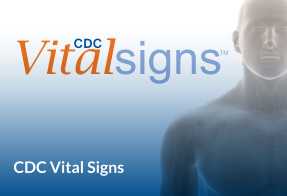Vital Signs Town Hall Teleconferences

Next Teleconference:
Increasing HIV Testing to Reduce Diagnosis Delays
December 5, 2017 • 2:00 to 3:00 PM (ET)
Recent Town Hall Teleconferences
Taking Action to Reduce Overweight- and Obesity-related Cancers
Overweight and obesity are associated with at least 13 different types of cancer. These cancers make up 40% of all cancers diagnosed. Most types of these cancers associated with overweight and obesity increased from 2005-2014. This teleconference featured a Vital Signs summary and discussion about programs that promote and support things people can do to lower their risk of getting cancer including maintaining a healthy weight.
Recent Trends in Stroke Death Rates
After decades of decline, progress has slowed in preventing stroke deaths. Almost 800,000 people have a stroke each year, more than 140,000 die and many survivors face disability. This is disturbing because about 80% of strokes are preventable. This teleconference featured a Vital Signs summary and discussion about how health systems are implementing programs that help address stroke risk factors and improve patient outcomes.
Promising Interventions to Improve Prescribing Practices within States
Healthcare providers began using opioids in the late 1990s to treat chronic pain (not related to cancer), such as arthritis and back pain. As this continued, more opioid prescriptions were written, for more days per prescription, in higher doses. Taking opioids for longer periods of time or in higher doses increases the risk of addiction, overdose, and death. This teleconference featured a Vital Signs summary and discussion about approaches to managing opioid prescribing practices.
Health Care-Associated Legionnaires’ Disease: Protect Patients with Prevention and Early Recognition
Legionnaires’ disease (LD) is a serious, and often deadly, lung infection (pneumonia). People usually get it by breathing in water droplets containing Legionella germs. Many people being treated at health care facilities, including long-term care facilities and hospitals, have conditions that put them at greater risk of getting sick and dying from LD. This teleconference featured a Vital Signs summary and discussion about actions that reduce the risk of Legionella growing and spreading in building water systems.
African American Health: Creating Equal Opportunities for Health
African Americans are living longer. The death rate for African Americans has declined about 25% over 17 years, primarily for those aged 65 years and older. Even with these improvements, new analysis shows that younger African Americans are living with or dying of many conditions typically found in white Americans at older ages. This teleconference featured a Vital Signs summary and discussion about health disparities and programs proven to reduce them and create opportunities for health.
Zika Virus: Protecting Pregnant Women and Babies
Zika virus infection (Zika) during pregnancy can cause damage to the brain, microcephaly, and congenital Zika syndrome, a pattern of conditions in the baby that includes brain abnormalities, eye defects, hearing loss, and limb defects. Pregnant women can protect their babies from these Zika-related health conditions by not traveling to areas with Zika. This teleconference featured a Vital Signs summary and discussion about surveillance of Zika virus and CDC’s recommendations for prevention.
Arthritis in America
Arthritis is a leading cause of disability. It causes pain, aching, stiffness, and swelling of the joints. Many adults with arthritis are prescribed opioid medicines, yet other options for pain are safer. Physical activity can decrease pain and improve physical function by about 40%. This teleconference featured a Vital Signs summary and discussion about how adults with arthritis can reduce their symptoms by participating in disease management education programs.
Too Loud for Too Long ― Loud Noises Damage Hearing
Hearing loss is the third most common chronic health condition in the US. Being around too much loud noise—like using a leaf blower or going to loud concerts—can cause permanent hearing loss. And once it’s gone, you can’t get it back! You can have hearing loss before you even notice you’re having problems. This teleconference featured a Vital Signs summary and discussion about how noise exposure can permanently damage hearing.
Good Healthcare Decreases Kidney Failure in Native Americans with Diabetes
Native Americans (American Indians and Alaska Natives) have a greater chance of having diabetes than any other US racial group. Diabetes is the leading cause of kidney failure, a costly condition that requires dialysis or kidney transplant for survival. This teleconference featured a Vital Signs summary and discussion about the declining rate of kidney failure from diabetes among Native Americans due to population health and team-based approaches to diabetes and kidney care.
Preventing HIV Among People Who Inject Drugs: The Vital Role of Syringe Services Programs
Sharing needles, syringes, and other injection equipment puts people who inject drugs (PWID) at high risk for getting HIV and other infections, including hepatitis. Syringe services programs (SSPs) can play a role in preventing HIV and other health problems among PWID. This teleconference featured a Vital Signs summary and discussion about programs that provide comprehensive services including access to sterile syringes, help with stopping substance misuse, and HIV testing and linkage to treatment.
Partnering to Reduce Tobacco-Related Cancers
Tobacco use is the leading preventable cause of cancer and cancer deaths. It can cause not only lung cancer, but also several other types of cancer. Each year, 660,000 people in the US are diagnosed with and 343,000 people die from a cancer related to tobacco use. We have made progress: more than 1 million tobacco-related cancer deaths have been avoided since 1990. This teleconference featured a Vital Signs summary and discussion about comprehensive cancer and tobacco control programs.

About Vital Signs Town Hall Teleconferences
On the Tuesday after the CDC Vital Signs report is released, OSTLTS hosts a town hall teleconference from 2 to 3 PM (ET) about the report’s topic. These monthly reports offer recent data and calls to action on important public health topics, and the teleconferences feature lessons learned and success stories from the state, tribal, local, or territorial perspective.
The town hall teleconferences were designed to provide a forum for our nation’s health officials to broaden the conversation, build momentum, and carry out evidence-based, effective programs within the public health areas covered by Vital Signs. We hope the town halls are relevant and useful to you in your work to protect and improve the health of the public. We welcome your feedback at OSTLTSFeedback@cdc.gov.
Share on Your Web Page
Copy the code from the Social Media for CDC Vital Signs page to add a button to your web site

- Page last reviewed: October 17, 2017
- Page last updated: October 17, 2017
- Content source:


 ShareCompartir
ShareCompartir




